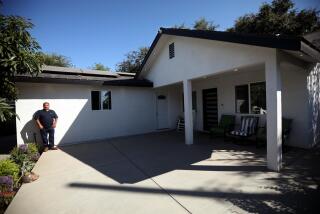Rein It In, Southland Office Developers Are Warned
Southland developers, who vastly overbuilt office space in the region during the cash-easy 1980s, are in danger of doing it again, a prominent real estate analyst warned.
All the businesses from Ventura County to San Diego combined will only need 2 million square feet of newly built space per year for the next decade, said economist and demographer David Birch of Cambridge, Mass.-based Cognetics Inc. That’s a fraction of the amount of office space planned or under construction.
“The economy is going to recover slowly, not explosively,” Birch said to the roomful of developers and brokers at a UCLA-sponsored event. “Don’t screw it up again.”
Using his firm’s database of information on corporate growth, Birch projected that demand for office space would grow fourfold over the next decade, bolstered by job creation and a growing demand for more office space per worker. But, he said, most of that can be accommodated by the existing supply of buildings in the Los Angeles Basin.
He cautioned that the same building fever that gripped Southern California in the late 1980s is once again smoldering. This time it isn’t savings and loans, Japanese conglomerates or life insurance companies pushing development over the top, but Wall Street firms ready to invest large amounts of public money in new development. “The REITs have found another sucker,” he quipped, referring to the collapse of real estate investment trusts in the 1970s.
Not surprisingly, REIT managers reject Birch’s gloomy prediction. They say few publicly traded entities will be allowed to build if developments aren’t yielding a good return.
“There’s an early warning system,” said John B. Kilroy Jr., chief executive of El Segundo-based Kilroy Realty Corp., which built 900,000 square feet of office space in San Diego last year and is planning an additional 3.3 million square feet of office construction across Southern California in the next three years. “REITs have a 90-day report card. Anyone can evaluate what a REIT is doing,” he said.
In other words, if analysts don’t think an REIT is meeting expectations, its share price will suffer and the company will find it hard to raise additional cash through a public offering.
But, said Birch, if developers are so restricted and sensible, are some economically healthy regions including Atlanta already becoming overbuilt?
“They are building 50% more space there than they are absorbing,” Birch said. That has dramatically boosted vacancy and is starting to drive rents down. “It doesn’t give me much confidence,” he said.
David Dale-Johnson, director of the real estate program at USC’s Marshall School of Business, predicts that as REITs become unable to find existing office buildings to purchase, most of them will look for land to develop.
“You’ve got people looking at speculative developments in most [Southern California] markets right now,” he said. Whether Wall Street will be better than bank regulators at reining in excessive development remains to be seen, he said.
In Glendale alone, one 520,000-square-foot speculative high-rise, Glendale Plaza, is under construction, another 23-story building is planned and several smaller office buildings are expected to be built in the coming year.
Is it too much? Perhaps, given that the first office building has yet to sign a major tenant.
“It does give you pause,” said Victor Feathers, a vice president with Reliance Development in Los Angeles, which was recently selected to build the 23-story building on Glendale’s Brand Boulevard. “But I think that you have to take the long view. L.A. is an engine running on all four cylinders. By the time Reliance is ready to construct its building, rents will be up there,” he said.
Such confidence is a contrast to remarks made as recently as a year ago, when many brokers and analysts said the region was still climbing out of a real estate depression. “I remember when we were saying Los Angeles may not need another office building for decades,” one broker recalled.
New buildings probably won’t be needed for the foreseeable future in slower markets such as downtown Los Angeles or Miracle Mile, Birch said. But certain markets, close to desirable neighborhoods or industry hubs, will be ripe for a few new buildings.
These “islands in a mud flat,” as Birch calls them, are the entertainment and technology hot spots of Glendale, Burbank, Santa Monica and Orange County’s John Wayne Airport area. Many companies in these locations are willing to pay premium rents in new buildings to keep their workers happy, and to stay close to other companies in their industry, he said.
But just how deep the demand is in these markets, and what price tenants will be willing to pay for rents, is uncertain, Birch said.
“Everybody thinks there’s a greater fool out there, someone who’s going to pay it,” Birch said, referring to the high rents of a new building. “Give a developer money and he will build.”
More to Read
Inside the business of entertainment
The Wide Shot brings you news, analysis and insights on everything from streaming wars to production — and what it all means for the future.
You may occasionally receive promotional content from the Los Angeles Times.










